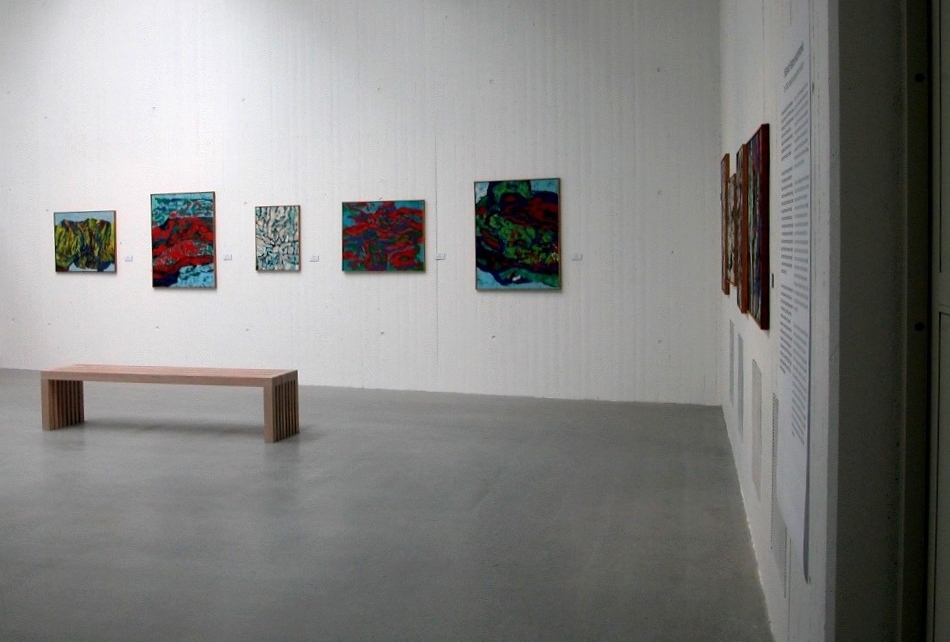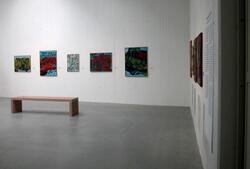
12 objects
Knut Rumohr was among the pioneers of modern Norwegian abstract painting. The exhibition is based on the extensive collection of paintings the artist left in the possession of his family. Many of the paintings have never been exhibited before. They were created in the time span from 1948 to 1998, and thus represent the entire range of Rumohr’s painting career. TEMPERAment seeks to shed light on the development of Rumohr’s paintings over time, i.e. of technique, mode of expression and content.
Rumohr was a versatile artist. He began his career as a graphic artist, but alongside of printmaking, he began to paint. The first paintings from the late 1930s were in oil. Around 1947-48 he changed medium and began working in tempera. To begin with, it was a welcome diversion from the woodcut, but beginning in the1970s painting became his main technique.
Rumohr developed his art parallel to other artists in the abstract and nonfigurative “spirit” of the 1940s and 50s, and like them, he eventually developed his uniqueness and his individual style in a way that we can recognise him – from decade to decade – regardless of any shift in technique. He can be placed within the “lyrical abstraction” movement that gradually dominated Europe after the Second World War, as a counterpart to America’s Abstract Expressionism. Both movements had a strong focus on intuition, spontaneity, the structure of the brushstroke and the tactile character of the paint.
The artist lived and worked for long periods of his adult life in Oslo, but up to four months each summer he lived with his family on his family’s estate, Frønningen, in the county of Sogn og Fjordane. Rumohr was uncommonly productive and exhibited frequently throughout his career. He represented Norway at the Venice Biennale in 1962, was the festival exhibitor at the Bergen International Festival in 1968, was accepted numerous times in the juried National Autumn Exhibition (Høstutstillingen) and participated in numerous collective exhibitions in Scandinavia and abroad. He served on a number of important and long-term committees and boards, such as the National Gallery’s acquisitions committee.
![Blått fjell [Maleri]](https://dms-cf-07.dimu.org/image/03349SehHJG9?dimension=250x250)
![Baugen [Maleri]](https://dms-cf-01.dimu.org/image/03349SehHJGA?dimension=250x250)
![Presten [Maleri]](https://dms-cf-06.dimu.org/image/03349SehHJBj?dimension=250x250)
![Komposisjon [Maleri]](https://dms-cf-02.dimu.org/image/03349SehHJBi?dimension=250x250)
![Hode [Maleri]](https://dms-cf-05.dimu.org/image/02349SehHJBm?dimension=250x250)
![Inntrykk fra Amerika I [Maleri]](https://dms-cf-07.dimu.org/image/03349SehHJBo?dimension=250x250)
![Aggressiv form [Maleri]](https://dms-cf-09.dimu.org/image/02349SehHJBn?dimension=250x250)
![Inntrykk fra Amerika II [Maleri]](https://dms-cf-08.dimu.org/image/03349SehHJBp?dimension=250x250)
![Landskap [Maleri]](https://dms-cf-08.dimu.org/image/02349SehHJBq?dimension=250x250)
![Former [Maleri]](https://dms-cf-03.dimu.org/image/02349SehHJBr?dimension=250x250)
![Flammende høst [Maleri]](https://dms-cf-06.dimu.org/image/03349SehHJG7?dimension=250x250)
![Sognejekt [Maleri]](https://dms-cf-09.dimu.org/image/02349SehHJG8?dimension=250x250)

Add a comment or suggest edits
To publish a public comment on the object, select «Leave a comment». To send an inquiry directly to the museum, select «Send an inquiry».